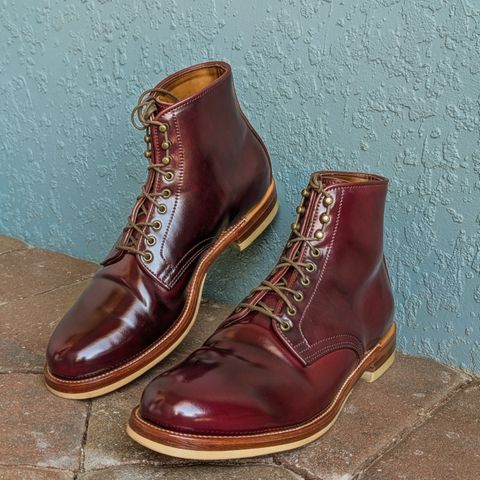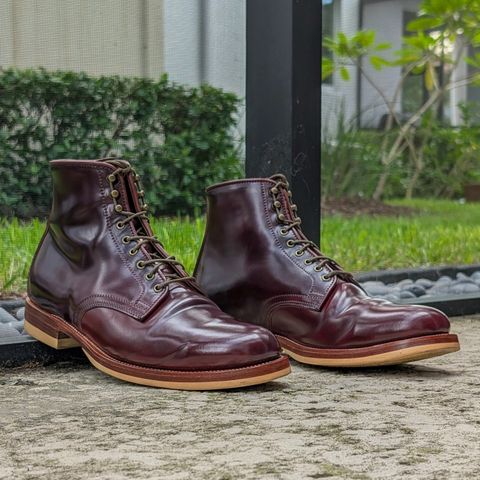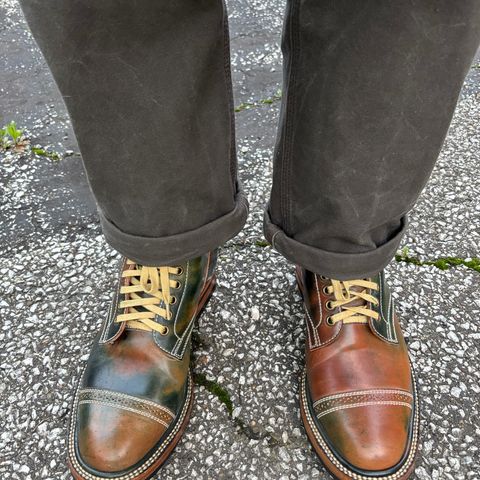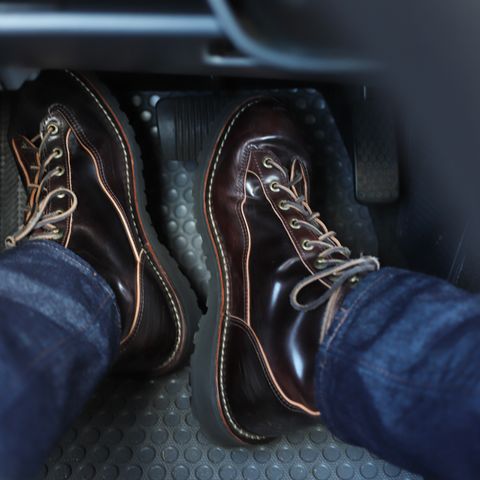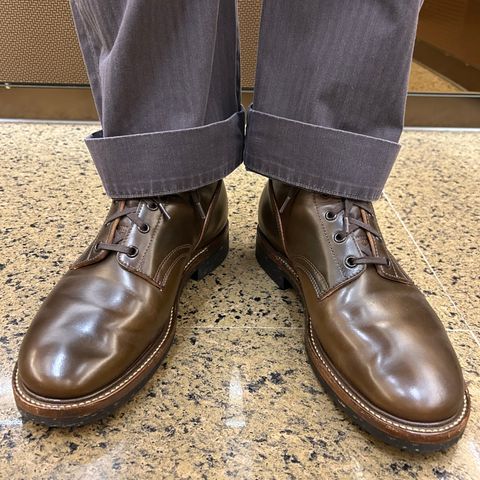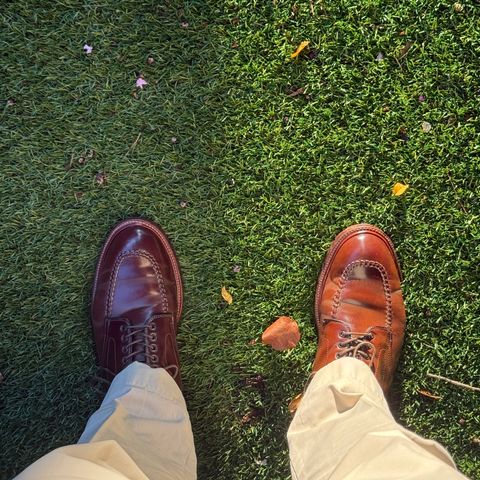About
Horween Shell Cordovan is a premium leather made from the subcutaneous membrane located in the rump area of horsehides, produced exclusively by Horween Leather Company in Chicago since 1905. Known for its tight grain structure that rolls instead of creasing, this vegetable-tanned leather is highly prized in heritage footwear manufacturing for its exceptional durability and ability to develop a distinctive patina with age.
About
Horween Shell Cordovan is a premium leather made from the subcutaneous membrane located in the rump area of horsehides, produced exclusively by Horween Leather Company in Chicago since 1905. Known for its tight grain structure that rolls instead of creasing, this vegetable-tanned leather is highly prized in heritage footwear manufacturing for its exceptional durability and ability to develop a distinctive patina with age.
The leather requires a complex production process taking 5-6 months from start to finish, involving traditional pit-tanning methods with chestnut and quebracho tree bark extracts followed by extensive hand-finishing by skilled artisans. Shell Cordovan's unique characteristics include naturally water-resistant properties, densely packed pores nearly invisible to the naked eye, and the ability to last a lifetime with proper care, making it one of the most sought-after materials for premium boots and shoes.
Manufacturing Process
The production of Shell Cordovan begins with horsehides sourced from countries like France, with only the butt portion of the hide suitable for tanning into this premium leather. The process starts with chemical hair removal and initial preparation, followed by a 24-hour visit to pickling paddles and a two-week rest period to prepare the hides for tanning.
The signature pit-tanning process occurs in two distinct stages, each lasting 30 days. The first stage uses a relatively mild tanning solution with light astringent properties, after which the butts are removed for trimming and light shaving to expose the shell layer. The second stage involves immersion in a more concentrated solution of chestnut and quebracho tree bark extracts, with the hides lightly agitated throughout the 60-day vegetable tanning process.
Following tanning, the leather undergoes a stuffing process where it is impregnated with a mixture of tallows and waxes in specialized drums, with the surface also receiving hand-applied oils. This is followed by a three-month rest period allowing complete penetration of these conditioning agents throughout the material.
The final processing stages involve complete shaving and trimming to create the characteristic oval-shaped shells, followed by dye application, hand-slicking to even the staining, and air drying. Each piece receives an application of Venetian Shoe Cream before being processed through glazing jacks with glass rods that smooth the fibers, followed by large rollers that flatten the shells for the final plating process.
Characteristics and Properties
Shell Cordovan possesses several unique characteristics that distinguish it from other leather types. The material creates a tight grain structure that rolls rather than creases when flexed, a property that helps prevent surface damage and contributes to the leather's exceptional longevity. This rolling behavior occurs because the leather is made from connective tissue rather than the outer skin layer, resulting in a smooth surface without the typical pebbled texture of conventional leather.
The leather is naturally water-resistant but not completely waterproof, with densely packed pores that are nearly invisible to the naked eye. This dense pore structure, combined with the vegetable tanning process, allows the leather to absorb oils, waxes, and conditioning agents evenly, enabling the development of a rich, even patina over time.
Shell Cordovan varies naturally in thickness from 3-4 oz (1.2-1.8mm), with centers typically measuring around 4 oz and outer edges tapering to 3-3.5 oz. The material is extremely durable, with well-maintained items capable of lasting a lifetime or more. Historical examples include watches from the 1930s and 1940s with Shell Cordovan straps that remain supple and show only a luxurious glow rather than wear.
History and Production
Horween Leather Company has been the exclusive producer of genuine Shell Cordovan since the company's founding in 1905 by Isidore Horween. The Chicago-based tannery moved to its current location at 2015 North Elston Avenue in 1920, where it continues to operate from a five-story, 200,000 square-foot facility. The company has remained family-owned for over five generations, making it one of the oldest continuously running tanneries in the United States.
As of 2012, the company employed 160 people with annual revenues of approximately $25 million, processing around 4,000 cowhides and 1,000 horsehides per week. The facility produces approximately 120,000 square feet of leather weekly, with Shell Cordovan representing a specialized portion of this output. Horween became Chicago's last remaining tannery in 2006, a city that once housed as many as 40 tanneries.
The company serves as the exclusive supplier of leather for NFL footballs, a contract held since 1941, and also supplies leather for NBA basketballs. Beyond sports equipment, Horween supplies leather to major footwear brands including Alden Shoe Company, Timberland, Cole Haan, Allen Edmonds, and Johnston & Murphy, with Alden being their largest Shell Cordovan customer since 1930.
Colors and Variations
Shell Cordovan is produced in various colors, each with signature names that have become standardized across the industry. Approximately 90% of Horween's Shell Cordovan production consists of Color #8 (a rich burgundy) and Black, with the remaining 10% comprising other color variations.
Color #8, often referred to simply as "Cordovan," features dark brown tones with burgundy and eggplant notes that can develop an extremely rich patina over time, with brighter, burnished tones of red emerging with wear. Black Shell Cordovan provides a classic, sleek appearance with a lustrous sheen that tends to be the most consistent in terms of color variation.
Natural Shell Cordovan represents the undyed version of the leather, finished with clear coats but no added colorants, allowing the natural characteristics of the vegetable-tanned horsehide to show through. Due to the hand-finishing process and natural characteristics of the material, color variations are expected even within the same production run.
Whiskey Shell Cordovan, once a popular variation, is no longer produced due to environmental regulations affecting the dyes required to achieve this color. The closest current alternative is Bourbon, though Whiskey had a more yellow tone compared to its replacement.
Care and Maintenance
Shell Cordovan requires specific care techniques that differ from conventional leather maintenance due to its unique properties and high oil content. The material should be conditioned sparingly, typically every 6 to 12 months, as over-conditioning can affect the leather's finish and performance.
Daily care involves using a soft, dry or slightly damp cloth to gently remove dust and dirt from the surface, avoiding vigorous rubbing that could affect the leather's distinctive finish. For deeper cleaning and maintenance, products such as Saphir, Kiwi, Kellys, or Venetian Cream are recommended, following manufacturer instructions for application.
The leather should be brushed vigorously with a horsehair brush to maintain its luster, followed by buffing with a smooth cloth. Wax or polish should be applied sparingly, approximately every 10-15 wearings for footwear, to maintain the protective coating without building up excessive product layers.
Shell Cordovan items should be stored away from direct sunlight and heat sources to prevent drying and color fading. Contact with oils, lotions, and other greasy products should be avoided as these can create permanent spots on the leather surface. When properly maintained, Shell Cordovan develops an increasingly rich appearance rather than showing wear, with the patina becoming deeper and more lustrous over time.
References
"Shell Cordovan Leather FAQs | What Is Cordovan Leather?". The Tannery Row. Retrieved September 5, 2025.
"Horween Shell Cordovan, Horse Leather". The Tannery Row. Retrieved September 5, 2025.
"Shell Cordovan Leather, Explained". Gentleman's Gazette. Retrieved September 5, 2025.
"Horween Shell Cordovan Collection". Crockett & Jones. Retrieved September 5, 2025.
